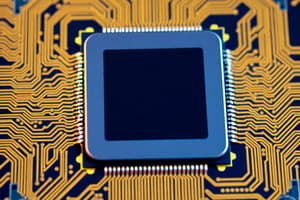Podcast
Questions and Answers
Which CPU register is responsible for holding the address of the instruction being executed?
Which CPU register is responsible for holding the address of the instruction being executed?
- Control
- Registers (correct)
- PSR
- ALU
What does the term 'load/store' refer to in processor architecture?
What does the term 'load/store' refer to in processor architecture?
- The process of loading data into registers from memory (correct)
- The process of storing data from registers into memory
- The process of swapping data between different registers
- The operation of fetching instructions from memory
Which type of processor architecture is known for its simplicity and reduced instruction set?
Which type of processor architecture is known for its simplicity and reduced instruction set?
- CISC
- ARM
- RISC (correct)
- Intels
What is the primary function of the ALU in a CPU?
What is the primary function of the ALU in a CPU?
In CPU terminology, what do branch instructions refer to?
In CPU terminology, what do branch instructions refer to?
Which type of processors, RISC or CISC, are known for encoding instructions with variable length?
Which type of processors, RISC or CISC, are known for encoding instructions with variable length?
Why do labels play a crucial role in assembly language programming?
Why do labels play a crucial role in assembly language programming?
What is the purpose of the Processor Status Register (PSR) in a CPU?
What is the purpose of the Processor Status Register (PSR) in a CPU?
Which type of processor architecture, RISC or CISC, is characterized by a larger number of addressing modes and instruction formats?
Which type of processor architecture, RISC or CISC, is characterized by a larger number of addressing modes and instruction formats?
What part of the CPU is mainly responsible for executing logical operations and arithmetic calculations?
What part of the CPU is mainly responsible for executing logical operations and arithmetic calculations?
How are branch instructions in a CPU different from other types of instructions?
How are branch instructions in a CPU different from other types of instructions?
Which part of the CPU is responsible for storing temporary data and intermediate results during processing?
Which part of the CPU is responsible for storing temporary data and intermediate results during processing?
What does the PSR (Processor Status Register) in a CPU primarily store?
What does the PSR (Processor Status Register) in a CPU primarily store?
In a typical CPU, what is the purpose of the Control Unit?
In a typical CPU, what is the purpose of the Control Unit?
What is the main difference between RISC and CISC processors in relation to memory access?
What is the main difference between RISC and CISC processors in relation to memory access?
Which type of processor architecture tends to have a simpler instruction set and focuses on executing more instructions per clock cycle?
Which type of processor architecture tends to have a simpler instruction set and focuses on executing more instructions per clock cycle?
Flashcards are hidden until you start studying
Study Notes
CPU Registers and Architecture
- The Program Counter (PC) register holds the address of the instruction currently being executed.
- 'Load/store' refers to a processor architecture design where operations are performed on data in registers, while memory access is limited to specific load and store instructions.
RISC vs. CISC
- RISC (Reduced Instruction Set Computer) is known for its simplicity and reduced instruction set, promoting faster execution.
- CISC (Complex Instruction Set Computer) processors are characterized by a larger number of addressing modes and instruction formats, allowing for more complex commands.
- RISC architecture typically has a simpler instruction set, focusing on executing more instructions per clock cycle.
Functions within the CPU
- The Arithmetic Logic Unit (ALU) is responsible for executing logical operations and arithmetic calculations.
- The Control Unit (CU) directs the operation of the processor, managing instruction execution and coordinating the activities of the ALU, registers, and memory.
- Branch instructions are a type of instruction that alters the flow of execution based on specific conditions, unlike regular instructions that execute in sequence.
Memory and Data Handling
- Temporary data and intermediate results during processing are managed by the CPU registers.
- The Processor Status Register (PSR) stores essential status flags which reflect the current state of the processor, helping in decision-making for conditional operations.
Assembly Language and Programming
- Labels are crucial in assembly language programming as they provide a means to reference particular instructions or memory addresses, enhancing readability and flow control in code.
Instruction Encoding
- CISC processors are known for encoding instructions with variable lengths, allowing for more complex operations in fewer lines of code compared to RISC processors, which typically utilize a fixed instruction length.
Key Differences in Memory Access
- The main distinction between RISC and CISC processors regarding memory access is that RISC architecture relies on load/store operations for accessing memory, while CISC can include memory operations directly in its instructions.
Studying That Suits You
Use AI to generate personalized quizzes and flashcards to suit your learning preferences.




